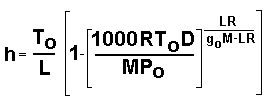| Flight Levels |
While fascinated by the recent eruption of the volcano Eyjafjallajokull in Iceland, I ran across charts of volcanic ash at FL200.
>FL-what?
My reaction, exactly. FL200 means flight level 20,000 feet ... so I decided to larn something about flight levels.
|
Aircraft have a device, the altimeter, to measure local air pressure.
Although it doesn't measure altitude, one can calculate the altitude if you know the air pressure at ground level. The difference in air pressure is a result of the weight of a column of air between ground level and the plane. Knowing something about the density of air, the force of gravity, temperature, etc., one can calculate the height of air (hence the altitude) from the pressure difference. In fact, one such magic formula (which gives the altitude, in feet, as a function of the two pressures: local and "reference") is: 
Of course, ya gotta be able to read and understand your altimeter, eh? >But that formula doesn't involve temperature, density ...
| 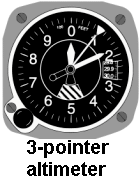 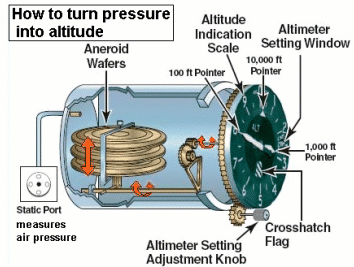 |
>Don't tell me you're gonna derive that formula! 
Maybe ... but, for now, I want to mention some other things -- like flight levels.
- Without knowing the pressure at ground level, your altimeter reading (which converts pressure to "altitude") may be way off.
- Pilots need to check ground level pressures as they fly from A to B.
My brother-in-law was a pilot in the RCAF. He often flew from a base in Alberta to Toronto.
He'd set his altimeter before he left the base, then reset it along the way. Else: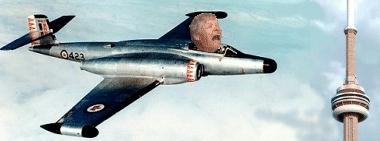
- Because ground-level pressures change from place to place, the "International Standard" is to assume that ground-level is sea-level.
Then the same (average) sea level pressure is used by all commercial flights as their reference level.
That gives what's called flight level. The last 2 digits are dropped, so a Flight Level of 20,000 feet is denoted by FL200.
Planes at different flight levels won't collide... and ground level pressure is then irrelevant.
In fact, to avoid collisions, their actual altitude isn't important.
Good question. I asked my brother-in-law. He says:
You set the local barometric pressure on the altimeter. You check the altitude on the altimeter with the height of the airport. It must be within 50 ft. Then when going up everyone sets the altimeter pressure at 29.92" of mercury once over 23000 ft or FL230. The only obstacles at that altitude would be Mt. Everest or another aircraft. With every aircraft set at the same setting there is no conflict. Most of the time Mt. Everest is not on your flight path so no worries there either. Once you approach an airport, prior to going through 23000 ft on your descent, you reset the altimeter to the local barometric pressure, one of the many pieces of data you get on approach. If you don't go to high altitudes (like for a small craft) you reset the altimeter's barometric pressure with the nearest airport along your route.On the other hand (I'm told by my wife's brother-in-law):
"Look out of your window and if you can see objects on the ground in distinct detail, you are flying too low.".

|
>But I thought that altimeters read altitude?
Actually, they read barometric pressure, then display altitude on the dial(s). It's like a medical thermometer. It actually reads the height of the column of mercury, but the numbers are in degrees. It's sorta like a ballon: you take it up to 20,000 ft. and it expands due to the decreased air pressure. Then you arrange to have a needle rotate because of the expansion ... and write altitude numbers by the needle. It ain't easy to directly measure altitude when you're 30,000 feet in the air -- but measuring outside pressure is easy. >But I thought GPS systems can read position ... hence altitude.
|  |
|
>Okay ... so measuring air pressure is easy. How would you do it?
Why, I'd build meself a Goethe Weatherglass Barometer. >Are you going to explain that awful formula for h, above?
| 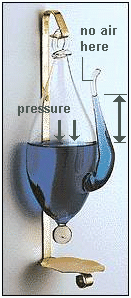 Goethe barometer |
| the Height formula |
We do this:
Yeah, remember when we talked about them guys when we measured blood sugar? >No ... but continue.
|  |
Yes ... and that means we integrate each side of [4] from z = 0 to z = h, to get the pressure at altitude h.
That gives:
[5]
 ... where log is the natural log, of course!
... where log is the natural log, of course!
This would give the pressure at altitude h. We just have to decide which variables are constant and which are dependent upon the elevation z.

For example, suppose everything is constant except the temperature. We'll assume it decreases with height like so:
[6] T = To - L z ... where To is the surface temperature and L is the rate of decrease.
That'd give (after integrating):
[7] log [P / Po] = (g M / LR) log[ (To - Lh) / To ]
Using [2], with T = To - L h, we can put P = D R (To - L h) / M ... then we'd have to solve for h.
Uh ... that's left as an exercise!
>Hey!
Actually, I don't think we'd get the same result. Let me check ... yes, it's the same, except for that ??? 1000 ???
[8] 
>So, how do you get that 1000?
I have no idea. 
Maybe it depends upon the units one uses. Maybe it's there to change grams to kilograms or meters to kilometers.
In any case, the magic formula [8] gives pressure altitude.
It may (or may not) agree with geometric altitude (which is what you'd measure with a ruler).
For example, if there's a lot of water vapour in the air, there could be significant errors in estimating "actual" altitude.
Then there's geopotential altitude which ...
>I don't want to know!
Me neither.
| the Magic Formula |
If we stick in the values for all parameters in [8] (according to the International Standard Atmosphere model of the atmosphere ... which is a standardized model so that predictable calculations can be made), but leave h and substitute for P from [2], we get (magic!):
|
[9] h = 44.3308 - 42.2665 P0.190263
where h is in kilometres and P is in Pascals. |
Now, my brother-in-law (my other brother-in-law) provided a neat table, like so 
Using that table (and converting miilibars to inches of mercury), we can compare to the numbers given by the magic formula [9] (after we converted km to feet and Pascals to in. mercury!) | 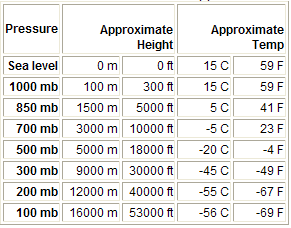 |
Check it out! Not bad, eh?

| 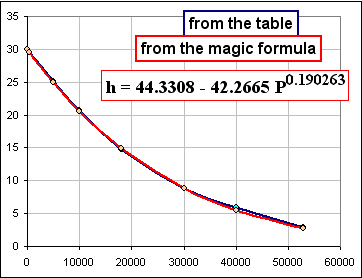 |
